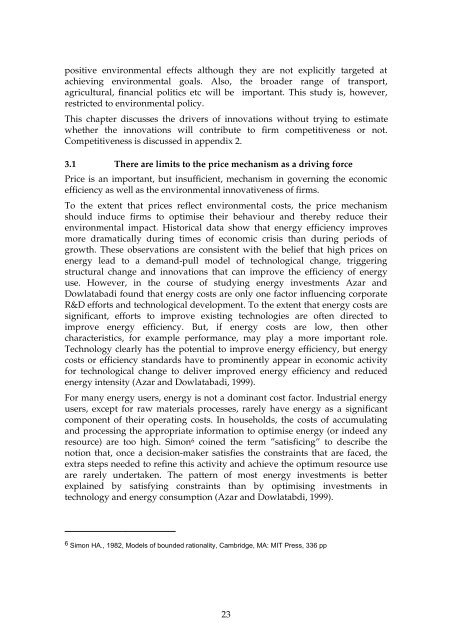Drivers of environmental innovation - Vinnova
Drivers of environmental innovation - Vinnova
Drivers of environmental innovation - Vinnova
Create successful ePaper yourself
Turn your PDF publications into a flip-book with our unique Google optimized e-Paper software.
positive <strong>environmental</strong> effects although they are not explicitly targeted at<br />
achieving <strong>environmental</strong> goals. Also, the broader range <strong>of</strong> transport,<br />
agricultural, financial politics etc will be important. This study is, however,<br />
restricted to <strong>environmental</strong> policy.<br />
This chapter discusses the drivers <strong>of</strong> <strong>innovation</strong>s without trying to estimate<br />
whether the <strong>innovation</strong>s will contribute to firm competitiveness or not.<br />
Competitiveness is discussed in appendix 2.<br />
3.1 There are limits to the price mechanism as a driving force<br />
Price is an important, but insufficient, mechanism in governing the economic<br />
efficiency as well as the <strong>environmental</strong> innovativeness <strong>of</strong> firms.<br />
To the extent that prices reflect <strong>environmental</strong> costs, the price mechanism<br />
should induce firms to optimise their behaviour and thereby reduce their<br />
<strong>environmental</strong> impact. Historical data show that energy efficiency improves<br />
more dramatically during times <strong>of</strong> economic crisis than during periods <strong>of</strong><br />
growth. These observations are consistent with the belief that high prices on<br />
energy lead to a demand-pull model <strong>of</strong> technological change, triggering<br />
structural change and <strong>innovation</strong>s that can improve the efficiency <strong>of</strong> energy<br />
use. However, in the course <strong>of</strong> studying energy investments Azar and<br />
Dowlatabadi found that energy costs are only one factor influencing corporate<br />
R&D efforts and technological development. To the extent that energy costs are<br />
significant, efforts to improve existing technologies are <strong>of</strong>ten directed to<br />
improve energy efficiency. But, if energy costs are low, then other<br />
characteristics, for example performance, may play a more important role.<br />
Technology clearly has the potential to improve energy efficiency, but energy<br />
costs or efficiency standards have to prominently appear in economic activity<br />
for technological change to deliver improved energy efficiency and reduced<br />
energy intensity (Azar and Dowlatabadi, 1999).<br />
For many energy users, energy is not a dominant cost factor. Industrial energy<br />
users, except for raw materials processes, rarely have energy as a significant<br />
component <strong>of</strong> their operating costs. In households, the costs <strong>of</strong> accumulating<br />
and processing the appropriate information to optimise energy (or indeed any<br />
resource) are too high. Simon 6 coined the term ”satisficing” to describe the<br />
notion that, once a decision-maker satisfies the constraints that are faced, the<br />
extra steps needed to refine this activity and achieve the optimum resource use<br />
are rarely undertaken. The pattern <strong>of</strong> most energy investments is better<br />
explained by satisfying constraints than by optimising investments in<br />
technology and energy consumption (Azar and Dowlatabdi, 1999).<br />
6 Simon HA., 1982, Models <strong>of</strong> bounded rationality, Cambridge, MA: MIT Press, 336 pp<br />
23

















